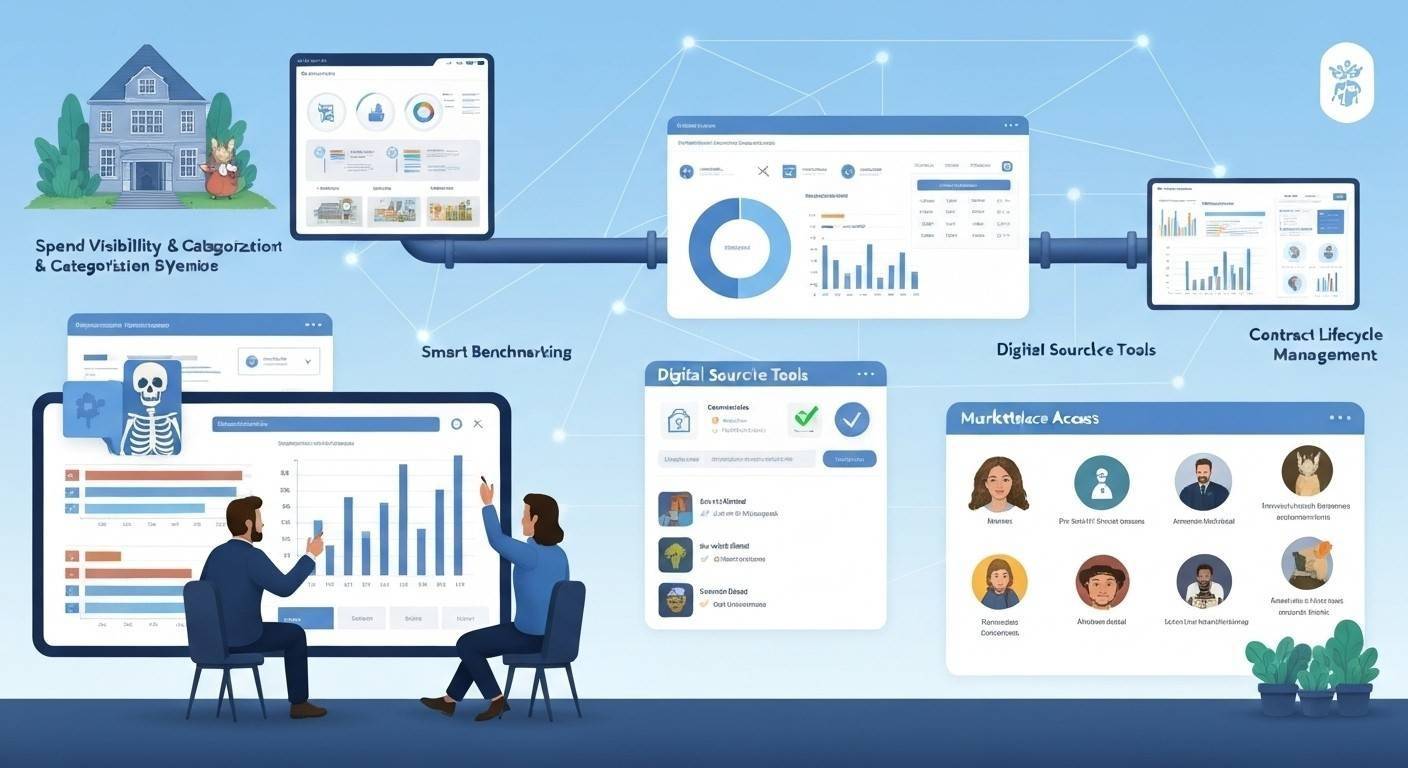Key Takeaways
Smaller hospitals often overlook purchased services like food, janitorial, IT, and waste management even though they represent a major budget line. Without oversight, contracts renew unnoticed, costs escalate, and performance suffers. This guide outlines a step-by-step roadmap to centralize data, benchmark vendors, renegotiate contracts, and adopt healthcare-specific tools like Valify. With smart optimization, even lean hospitals can save money, boost vendor accountability, and reinvest in patient care.
A Step by Step Guide to Purchased Services Optimization for Smaller Hospitals
Running lean isn’t just smart, it’s survival. Smaller hospitals, in particular, walk a tightrope. Margins are thin, teams are stretched, and every decision counts. But here’s something many overlook: purchased services in healthcare.
The behind-the-scenes essentials: food service, IT support, janitorial contracts, waste hauling, keep your hospital humming. They don’t involve direct labor, so they’re easy to ignore. But that’s precisely why they need a closer look.
This guide gives you a step-by-step plan to take control. It’s not about cutting corners, it’s about getting smarter. With the right moves, even the smallest facility can save real money, improve vendor performance, and channel resources back to what matters: patient care.
Why Purchased Services Deserve Strategic Focus
They’re a Major Budget Line
Let’s be honest: How often do you consider your total spending on purchased services? It’s easy to miss because costs are spread across different departments or buried under generic categories. But when you pull it all together, the total can be staggering.
Even modest monthly bills for hospital purchased services add up to six figures over a year. And that’s money that could be powering clinical innovation, hiring, or tech upgrades.
Commonly Overlooked
Why do purchased services get so little love? Simple: no one owns them. Different teams manage different vendors. Contracts roll over year after year with barely a glance. There’s no central oversight, no tracking, no real accountability.
It’s not that people don’t care; they’re busy. But letting these expenses drift unchecked leads to quiet, steady overspending.
Not Just About Cutting Costs
Yes, savings are part of the story, but not the whole story. Optimization is really about strategy. It’s about aligning vendor services with your goals, improving outcomes, and eliminating operational waste.
When done right, optimizing purchased services supports long-term sustainability. It frees up money you can reallocate to better care and stronger teams.
Key Challenges Small Hospitals Face
Siloed or Incomplete Data
Does your vendor data live in a shared drive? A spreadsheet? Someone’s inbox? Maybe all three? That’s a problem.
Without a single source of truth, it’s almost impossible to see where the money is going. You can’t analyze spending patterns, track usage, or make informed decisions when the data is scattered like confetti.
Limited Contract Oversight
Smaller hospitals often have incredible people doing the work of entire departments. But that also means contracts get filed and forgotten. Renewal dates slip by. Terms aren’t reviewed. And when something goes wrong? It’s already too late.
This isn’t just inconvenient; it opens the door to compliance risks, poor service, and unexpected costs.
No Market Benchmarking
Here’s a tricky question: Are you overpaying for services? Without benchmarks, there’s no way to know.
Many hospitals are flying blind in negotiations. Vendors might be charging more than the market average, unless you’ve seen the data, you wouldn’t know it. That lack of context puts you at a significant disadvantage.
Manual Processes, Small Teams
No procurement department? No problem, until it is.
In small hospitals, one person may be juggling finance, facilities, contracts, and more. Optimization becomes a back-burner project when everything’s manual and time is tight. But the longer it waits, the more dollars slip away.
Step-by-Step Roadmap to Optimization
1. Centralize and Standardize Data
First things first: gather all vendor contracts and invoices in one place. Doesn’t matter if it’s a digital platform or a dedicated folder. The goal? Clearly describe your spend, service categories, and vendor relationships.
Use a standard classification system (like Valify’s) to group services. You might discover you’re paying two vendors for nearly the same job. That overlap? It’s costing you.
Bonus tip: highlight contracts that are about to expire. These are prime opportunities for quick wins.
2. Prioritize What to Tackle First
Don’t try to fix everything at once. That’s a fast track to burnout. Instead, zoom in on categories that are easy to fix and have the biggest payoff.
Start with non-clinical services that cost a lot but aren’t overly complex, like healthcare food service , laundry, and janitorial.
Check which contracts are up for renewal soon. Those are your low-hanging fruit.
Also, listen to your staff. Complaints often point to areas of poor value or underperformance.
3. Use Benchmarking to Make Smarter Decisions
This is where things get powerful. Benchmarking gives you complex data, real comparisons on what similar hospitals pay for the same services.
Tools like Valify offer national and regional pricing data. With that knowledge, you gain serious leverage when it’s time to negotiate. You stop guessing and start dealing with purpose.
Plus, you’ll spot where price differences are most significant. That helps you focus on the categories with the most savings potential.
4. Engage Department Stakeholders
This isn’t a solo mission. Get the people who use these services involved: nurses, environmental staff, food services, and facilities.
Their input makes the data more accurate, and their buy-in helps changes stick. Assign contract ownership to someone in each department so accountability is clear.
Vendor performance becomes a shared responsibility when everyone’s invested, not just a back-office task.
5. Renegotiate with Data-Driven Strategies
Now you’re ready to go back to your vendors. Prepare with benchmark data, internal usage stats, and clear expectations.
Ask for service level agreements (SLAs) that mean something.
Set KPIs that tie to results, not just activity.
Bundle services across departments to drive efficiency.
And remember, this isn’t about being aggressive. It’s about alignment. The goal is to create win-win partnerships where both sides see value.
6. Monitor and Iterate
Optimization isn’t a one-and-done project. It’s a rhythm.
Use dashboards or reports to monitor vendor performance, cost savings, and contract compliance. Confirm that what was promised on paper is showing up in practice.
Set regular review meetings, quarterly or twice a year. Make it a habit, not a hassle.
Choose the Right Technology for Purchased Services Optimization
Focus on Tools That Support Key Tasks
You don’t need an overwhelming platform with a thousand features. You need one that does a few things well: centralizes vendor data, tracks spend, benchmarks pricing, and monitors performance.
That’s it. Simple, practical, powerful.
Avoid Overbuilt Enterprise Platforms
Big-name ERP systems might look impressive, but they’re often built for larger organizations. They come with high costs, long onboarding times, and heavy IT demands.
For smaller hospitals, they’re often more of a hassle than help. Stick with lightweight tools explicitly designed for purchased services.
Select Healthcare-Specific Tools
Hospitals aren’t just businesses; they’re complex care ecosystems. Generic procurement tools don’t understand the nuances of compliance, clinical priorities, or service types.
Look for a tool built with healthcare in mind. It’ll save you a lot of frustration.
Prioritize Simplicity and Scalability
The right tool should be easy to roll out, simple to use, and flexible enough to grow with you. If it takes months to implement or needs constant IT support, it’s the wrong fit.
Your team is already busy, don’t add friction.
Support Decisions with Vendor-Neutral Insights
Beware of platforms that steer you toward certain vendors. The best tools offer unbiased data and let you decide what works.
Vendor-neutral insights help you make confident, informed decisions based on facts, not sales pitches.
Consider Purpose-Built Solutions Like Valify
Valify is made for healthcare-purchased services. It tracks spending, benchmarks pricing, shows contract timelines, and helps you spot opportunities without pushing any vendors.
It’s lean, focused, and ideal for hospitals that want clarity without complexity.
Conclusion
Let’s be clear: optimizing purchased services isn’t out of reach. Even if your hospital is small or short-staffed, you can still improve significantly. Start small. Centralize your data. Tackle easy wins. Use benchmarking to guide your decisions. One step at a time, you’ll build momentum.
And no, you don’t have to do it all alone.
Platforms like Valify provide structure, insights, and healthcare-specific guidance to simplify and measure optimization. Whether you’re renegotiating contracts or just trying to get a clearer picture of spending, it helps you move forward confidently.
Because in the end, efficiency doesn’t require complexity. It just takes focus and the proper support.
FAQs:
Which purchased services should we optimize first?
Start with high-spend, non-clinical services that are easy to manage,
like janitorial, laundry, food, or hospital waste management. These areas typically offer quick wins with minimal risk. Also, focus on contracts up for renewal soon to make timely and strategic changes.
What data is critical before reviewing vendors?
You’ll need clear visibility into contract terms, expiration dates, and total spend per vendor. Feedback from departments using the services is also essential. Most of all, benchmark pricing data helps you understand if you’re overpaying and gives you leverage during negotiations.
How often should we revisit contracts?
Ideally, review contracts annually, even if they’re long-term. At the very least, evaluate them 3–4 months before renewal. This gives you enough time to assess performance, compare pricing, and renegotiate if needed, without getting stuck in automatic extensions.
Are there risks in being too aggressive?
Yes. Cutting costs too aggressively can reduce service quality or create compliance issues. The goal should be to balance and reduce waste while maintaining reliable performance. Aim for fair value, and include clear service standards in every contract.
Can benchmarking help rural or independent hospitals?
Absolutely. Smaller or rural hospitals often lack negotiation power, and benchmarking gives them much-needed insight. It helps identify fair pricing and strengthens your position, even when resources or vendor options are limited.

Shara Smith serves as the Marketing Director for both Valify and Valify Solutions Group, where she oversees all facets of marketing, including strategic planning, branding, digital marketing, and event management. She joined Valify in September 2021, bringing with her a wealth of experience in healthcare marketing and business development.

